Report: Legal and Ethical Challenges of E-Health and M-Health
VerifiedAdded on 2021/10/04
|11
|2479
|388
Report
AI Summary
This report provides a comprehensive overview of the legal and ethical challenges associated with eHealth and mHealth systems. It begins with an introduction to Electronic Medical Records (EMR), detailing their advantages and the challenges they pose, particularly regarding privacy and data protection. The report emphasizes the importance of privacy in EMRs, discussing access control, security issues, and the use of patient information by health professionals. It explores relevant privacy laws, specifically focusing on Australian legislation, and identifies ethical and legal challenges such as data breaches and compliance with regulations. The report concludes with recommendations for enhancing data protection and privacy in e-health, including controlled data sharing, robust security measures, and regular monitoring, ultimately aiming to balance the benefits of eHealth with the imperative of protecting patient data. The report uses the work of several authors to back up the points being made.
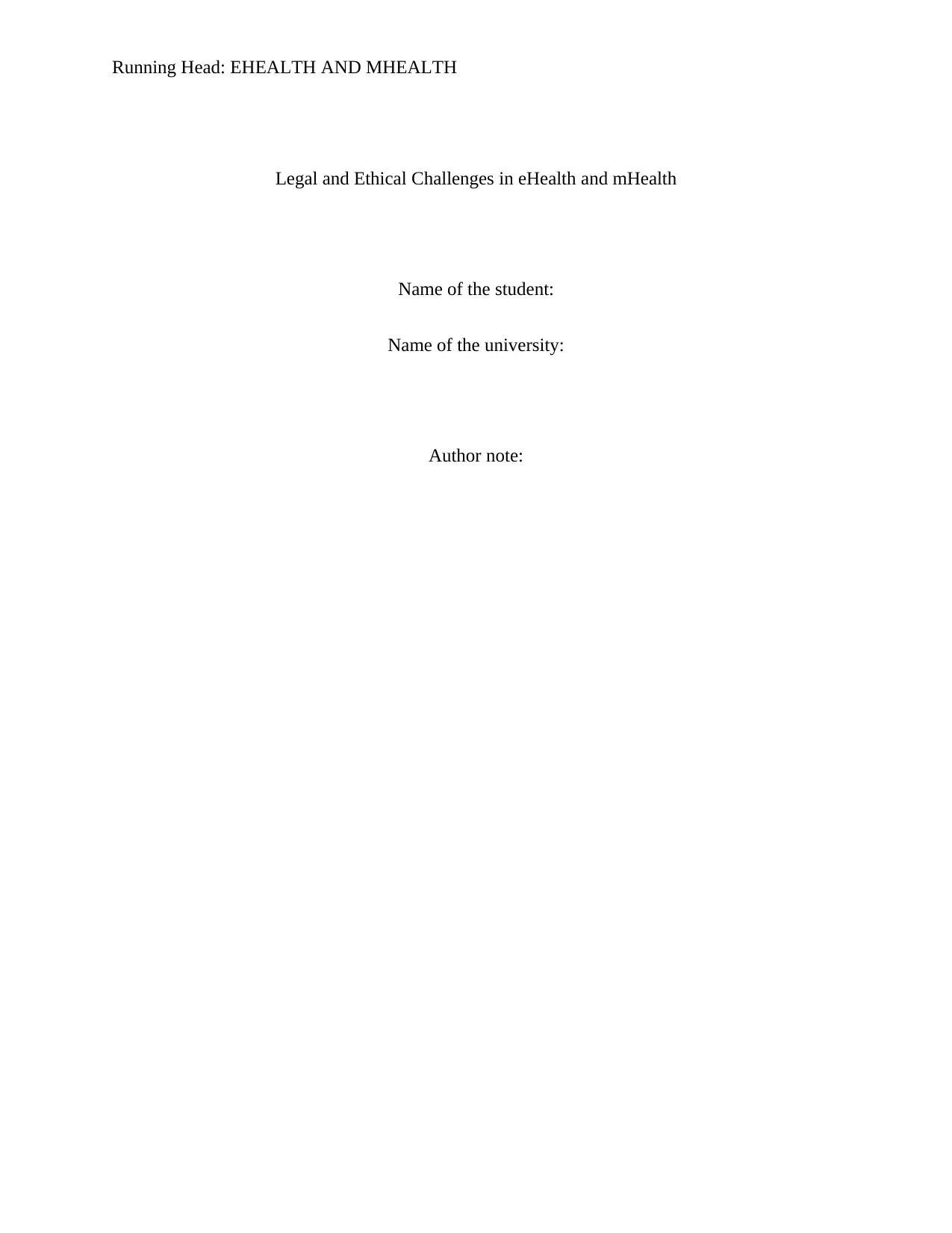
Running Head: EHEALTH AND MHEALTH
Legal and Ethical Challenges in eHealth and mHealth
Name of the student:
Name of the university:
Author note:
Legal and Ethical Challenges in eHealth and mHealth
Name of the student:
Name of the university:
Author note:
Paraphrase This Document
Need a fresh take? Get an instant paraphrase of this document with our AI Paraphraser
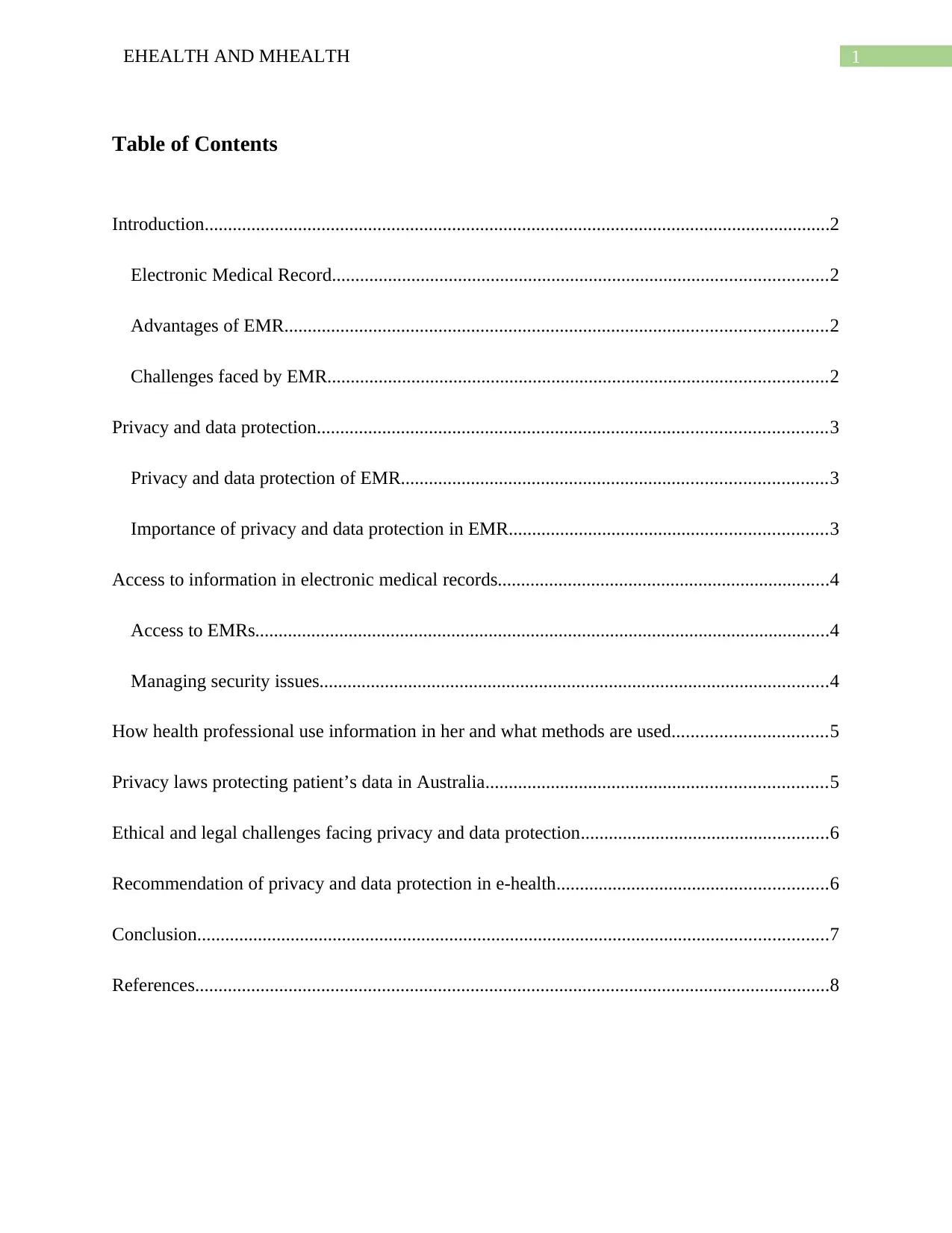
1EHEALTH AND MHEALTH
Table of Contents
Introduction......................................................................................................................................2
Electronic Medical Record..........................................................................................................2
Advantages of EMR....................................................................................................................2
Challenges faced by EMR...........................................................................................................2
Privacy and data protection.............................................................................................................3
Privacy and data protection of EMR...........................................................................................3
Importance of privacy and data protection in EMR....................................................................3
Access to information in electronic medical records.......................................................................4
Access to EMRs...........................................................................................................................4
Managing security issues.............................................................................................................4
How health professional use information in her and what methods are used.................................5
Privacy laws protecting patient’s data in Australia.........................................................................5
Ethical and legal challenges facing privacy and data protection.....................................................6
Recommendation of privacy and data protection in e-health..........................................................6
Conclusion.......................................................................................................................................7
References........................................................................................................................................8
Table of Contents
Introduction......................................................................................................................................2
Electronic Medical Record..........................................................................................................2
Advantages of EMR....................................................................................................................2
Challenges faced by EMR...........................................................................................................2
Privacy and data protection.............................................................................................................3
Privacy and data protection of EMR...........................................................................................3
Importance of privacy and data protection in EMR....................................................................3
Access to information in electronic medical records.......................................................................4
Access to EMRs...........................................................................................................................4
Managing security issues.............................................................................................................4
How health professional use information in her and what methods are used.................................5
Privacy laws protecting patient’s data in Australia.........................................................................5
Ethical and legal challenges facing privacy and data protection.....................................................6
Recommendation of privacy and data protection in e-health..........................................................6
Conclusion.......................................................................................................................................7
References........................................................................................................................................8
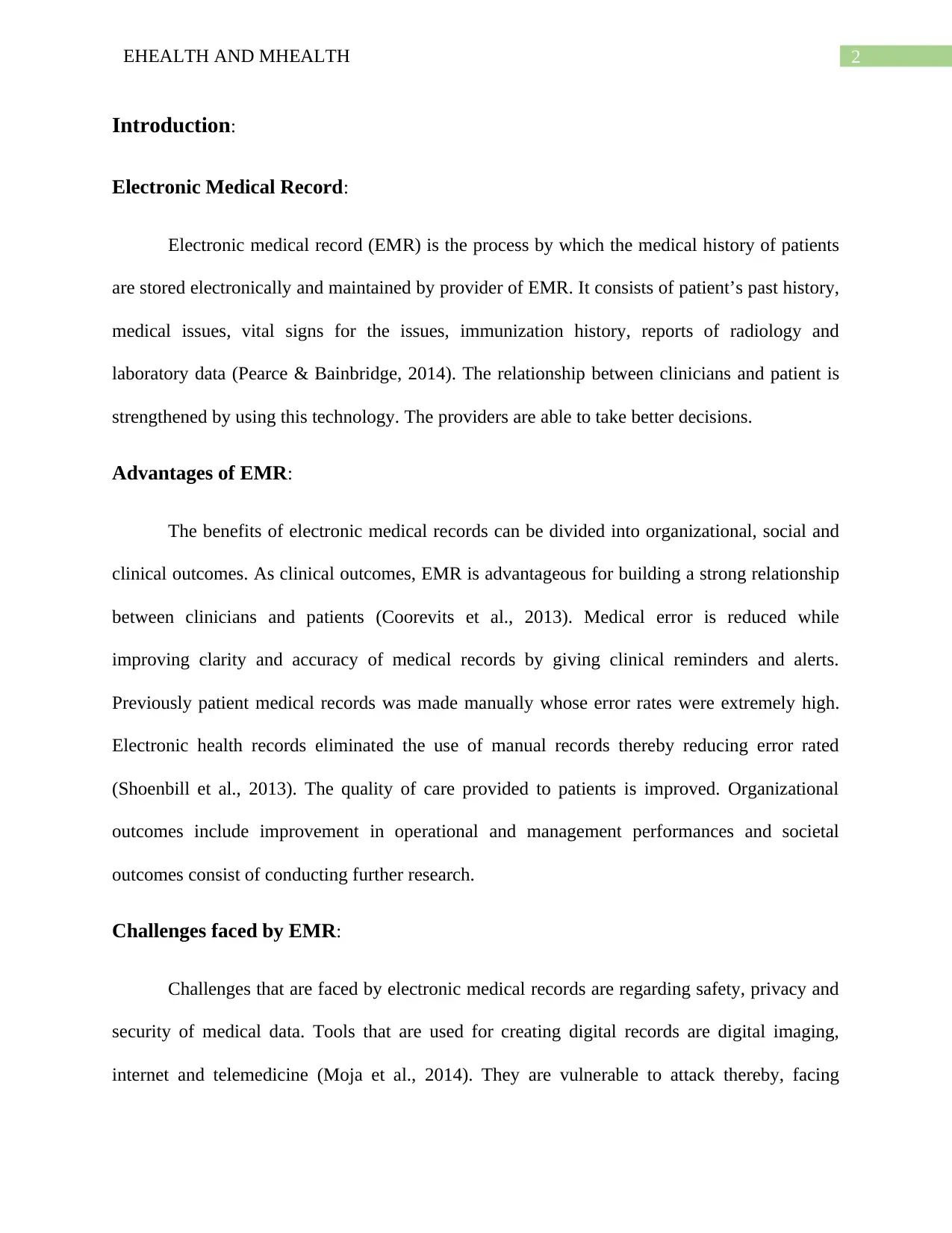
2EHEALTH AND MHEALTH
Introduction:
Electronic Medical Record:
Electronic medical record (EMR) is the process by which the medical history of patients
are stored electronically and maintained by provider of EMR. It consists of patient’s past history,
medical issues, vital signs for the issues, immunization history, reports of radiology and
laboratory data (Pearce & Bainbridge, 2014). The relationship between clinicians and patient is
strengthened by using this technology. The providers are able to take better decisions.
Advantages of EMR:
The benefits of electronic medical records can be divided into organizational, social and
clinical outcomes. As clinical outcomes, EMR is advantageous for building a strong relationship
between clinicians and patients (Coorevits et al., 2013). Medical error is reduced while
improving clarity and accuracy of medical records by giving clinical reminders and alerts.
Previously patient medical records was made manually whose error rates were extremely high.
Electronic health records eliminated the use of manual records thereby reducing error rated
(Shoenbill et al., 2013). The quality of care provided to patients is improved. Organizational
outcomes include improvement in operational and management performances and societal
outcomes consist of conducting further research.
Challenges faced by EMR:
Challenges that are faced by electronic medical records are regarding safety, privacy and
security of medical data. Tools that are used for creating digital records are digital imaging,
internet and telemedicine (Moja et al., 2014). They are vulnerable to attack thereby, facing
Introduction:
Electronic Medical Record:
Electronic medical record (EMR) is the process by which the medical history of patients
are stored electronically and maintained by provider of EMR. It consists of patient’s past history,
medical issues, vital signs for the issues, immunization history, reports of radiology and
laboratory data (Pearce & Bainbridge, 2014). The relationship between clinicians and patient is
strengthened by using this technology. The providers are able to take better decisions.
Advantages of EMR:
The benefits of electronic medical records can be divided into organizational, social and
clinical outcomes. As clinical outcomes, EMR is advantageous for building a strong relationship
between clinicians and patients (Coorevits et al., 2013). Medical error is reduced while
improving clarity and accuracy of medical records by giving clinical reminders and alerts.
Previously patient medical records was made manually whose error rates were extremely high.
Electronic health records eliminated the use of manual records thereby reducing error rated
(Shoenbill et al., 2013). The quality of care provided to patients is improved. Organizational
outcomes include improvement in operational and management performances and societal
outcomes consist of conducting further research.
Challenges faced by EMR:
Challenges that are faced by electronic medical records are regarding safety, privacy and
security of medical data. Tools that are used for creating digital records are digital imaging,
internet and telemedicine (Moja et al., 2014). They are vulnerable to attack thereby, facing
⊘ This is a preview!⊘
Do you want full access?
Subscribe today to unlock all pages.

Trusted by 1+ million students worldwide
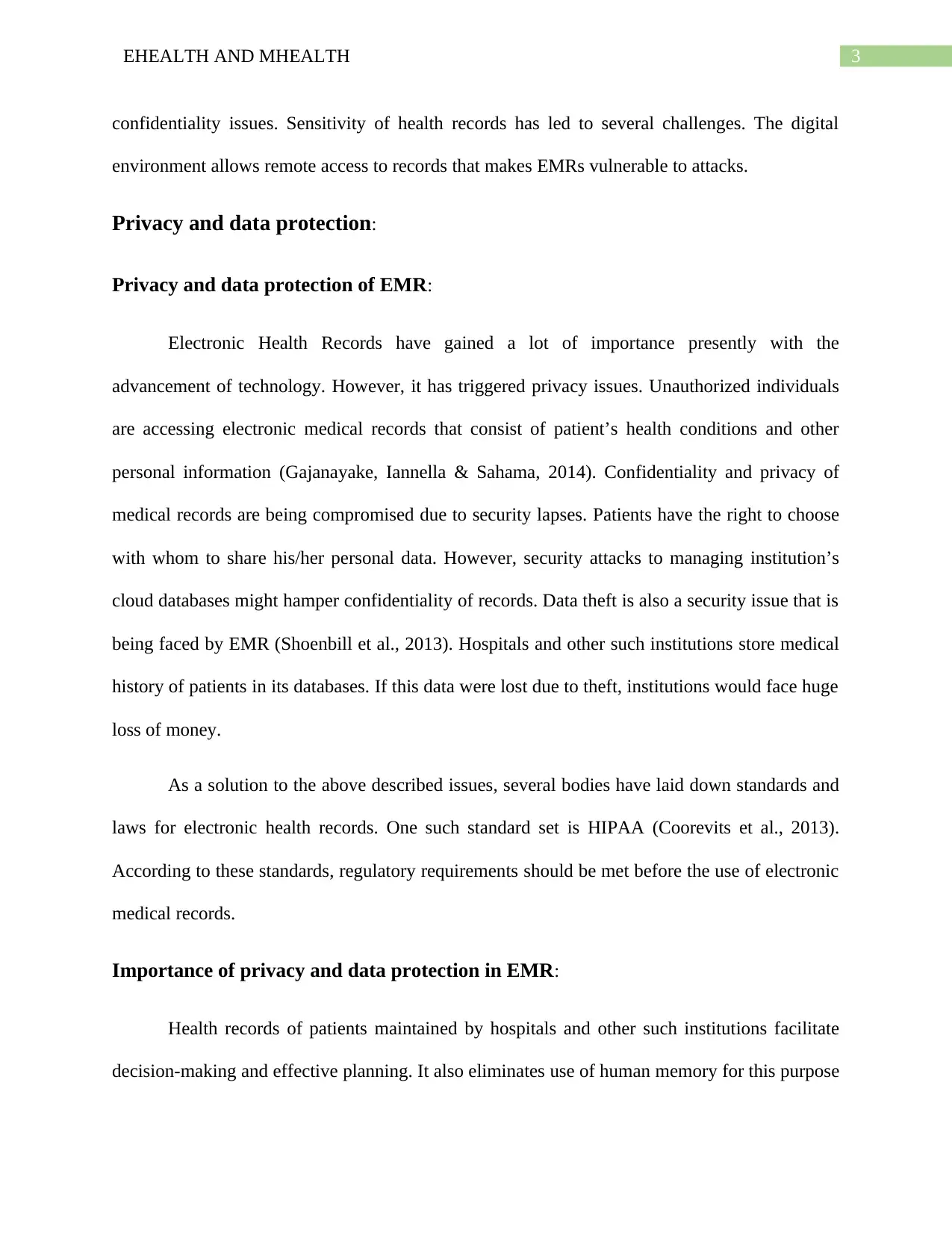
3EHEALTH AND MHEALTH
confidentiality issues. Sensitivity of health records has led to several challenges. The digital
environment allows remote access to records that makes EMRs vulnerable to attacks.
Privacy and data protection:
Privacy and data protection of EMR:
Electronic Health Records have gained a lot of importance presently with the
advancement of technology. However, it has triggered privacy issues. Unauthorized individuals
are accessing electronic medical records that consist of patient’s health conditions and other
personal information (Gajanayake, Iannella & Sahama, 2014). Confidentiality and privacy of
medical records are being compromised due to security lapses. Patients have the right to choose
with whom to share his/her personal data. However, security attacks to managing institution’s
cloud databases might hamper confidentiality of records. Data theft is also a security issue that is
being faced by EMR (Shoenbill et al., 2013). Hospitals and other such institutions store medical
history of patients in its databases. If this data were lost due to theft, institutions would face huge
loss of money.
As a solution to the above described issues, several bodies have laid down standards and
laws for electronic health records. One such standard set is HIPAA (Coorevits et al., 2013).
According to these standards, regulatory requirements should be met before the use of electronic
medical records.
Importance of privacy and data protection in EMR:
Health records of patients maintained by hospitals and other such institutions facilitate
decision-making and effective planning. It also eliminates use of human memory for this purpose
confidentiality issues. Sensitivity of health records has led to several challenges. The digital
environment allows remote access to records that makes EMRs vulnerable to attacks.
Privacy and data protection:
Privacy and data protection of EMR:
Electronic Health Records have gained a lot of importance presently with the
advancement of technology. However, it has triggered privacy issues. Unauthorized individuals
are accessing electronic medical records that consist of patient’s health conditions and other
personal information (Gajanayake, Iannella & Sahama, 2014). Confidentiality and privacy of
medical records are being compromised due to security lapses. Patients have the right to choose
with whom to share his/her personal data. However, security attacks to managing institution’s
cloud databases might hamper confidentiality of records. Data theft is also a security issue that is
being faced by EMR (Shoenbill et al., 2013). Hospitals and other such institutions store medical
history of patients in its databases. If this data were lost due to theft, institutions would face huge
loss of money.
As a solution to the above described issues, several bodies have laid down standards and
laws for electronic health records. One such standard set is HIPAA (Coorevits et al., 2013).
According to these standards, regulatory requirements should be met before the use of electronic
medical records.
Importance of privacy and data protection in EMR:
Health records of patients maintained by hospitals and other such institutions facilitate
decision-making and effective planning. It also eliminates use of human memory for this purpose
Paraphrase This Document
Need a fresh take? Get an instant paraphrase of this document with our AI Paraphraser
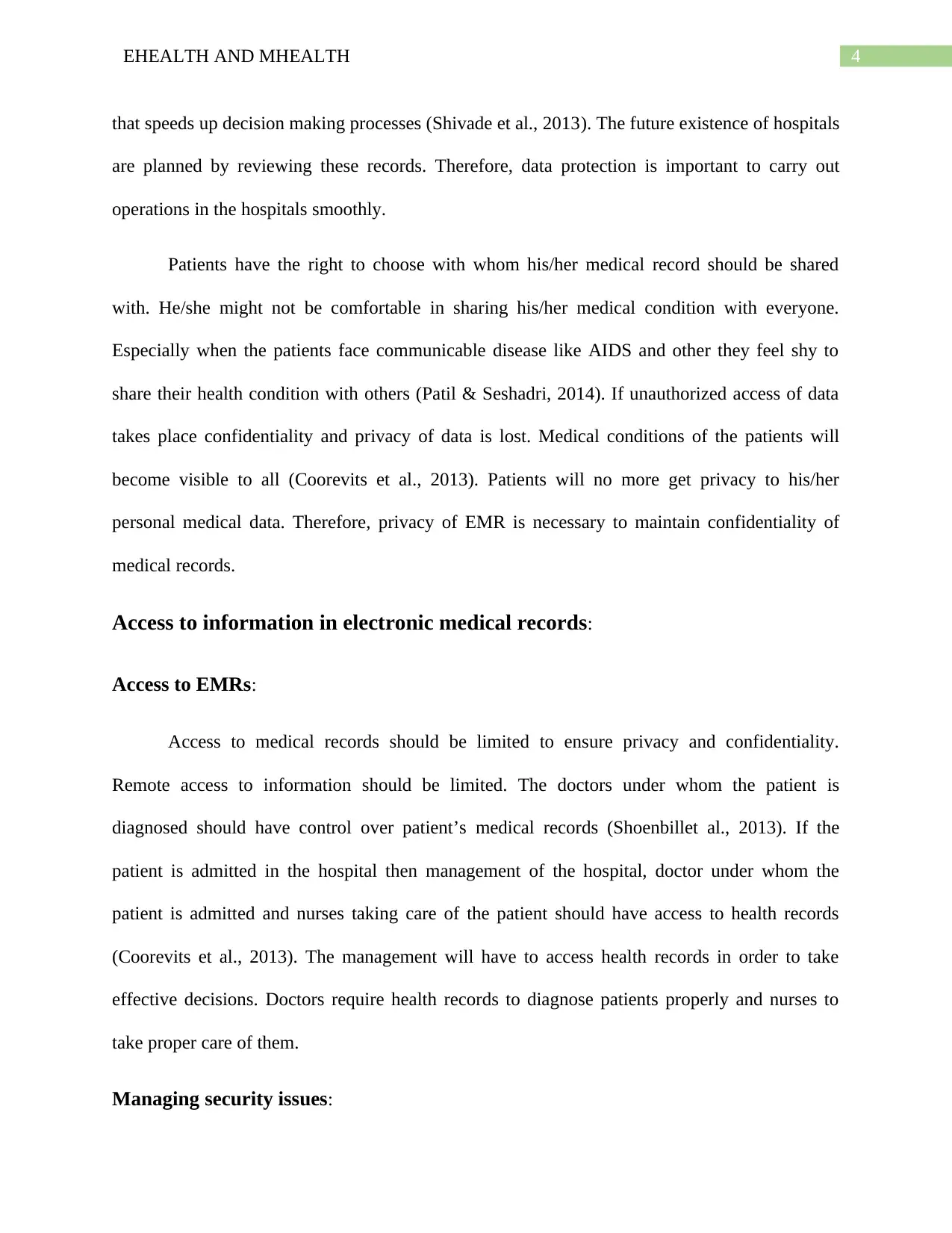
4EHEALTH AND MHEALTH
that speeds up decision making processes (Shivade et al., 2013). The future existence of hospitals
are planned by reviewing these records. Therefore, data protection is important to carry out
operations in the hospitals smoothly.
Patients have the right to choose with whom his/her medical record should be shared
with. He/she might not be comfortable in sharing his/her medical condition with everyone.
Especially when the patients face communicable disease like AIDS and other they feel shy to
share their health condition with others (Patil & Seshadri, 2014). If unauthorized access of data
takes place confidentiality and privacy of data is lost. Medical conditions of the patients will
become visible to all (Coorevits et al., 2013). Patients will no more get privacy to his/her
personal medical data. Therefore, privacy of EMR is necessary to maintain confidentiality of
medical records.
Access to information in electronic medical records:
Access to EMRs:
Access to medical records should be limited to ensure privacy and confidentiality.
Remote access to information should be limited. The doctors under whom the patient is
diagnosed should have control over patient’s medical records (Shoenbillet al., 2013). If the
patient is admitted in the hospital then management of the hospital, doctor under whom the
patient is admitted and nurses taking care of the patient should have access to health records
(Coorevits et al., 2013). The management will have to access health records in order to take
effective decisions. Doctors require health records to diagnose patients properly and nurses to
take proper care of them.
Managing security issues:
that speeds up decision making processes (Shivade et al., 2013). The future existence of hospitals
are planned by reviewing these records. Therefore, data protection is important to carry out
operations in the hospitals smoothly.
Patients have the right to choose with whom his/her medical record should be shared
with. He/she might not be comfortable in sharing his/her medical condition with everyone.
Especially when the patients face communicable disease like AIDS and other they feel shy to
share their health condition with others (Patil & Seshadri, 2014). If unauthorized access of data
takes place confidentiality and privacy of data is lost. Medical conditions of the patients will
become visible to all (Coorevits et al., 2013). Patients will no more get privacy to his/her
personal medical data. Therefore, privacy of EMR is necessary to maintain confidentiality of
medical records.
Access to information in electronic medical records:
Access to EMRs:
Access to medical records should be limited to ensure privacy and confidentiality.
Remote access to information should be limited. The doctors under whom the patient is
diagnosed should have control over patient’s medical records (Shoenbillet al., 2013). If the
patient is admitted in the hospital then management of the hospital, doctor under whom the
patient is admitted and nurses taking care of the patient should have access to health records
(Coorevits et al., 2013). The management will have to access health records in order to take
effective decisions. Doctors require health records to diagnose patients properly and nurses to
take proper care of them.
Managing security issues:
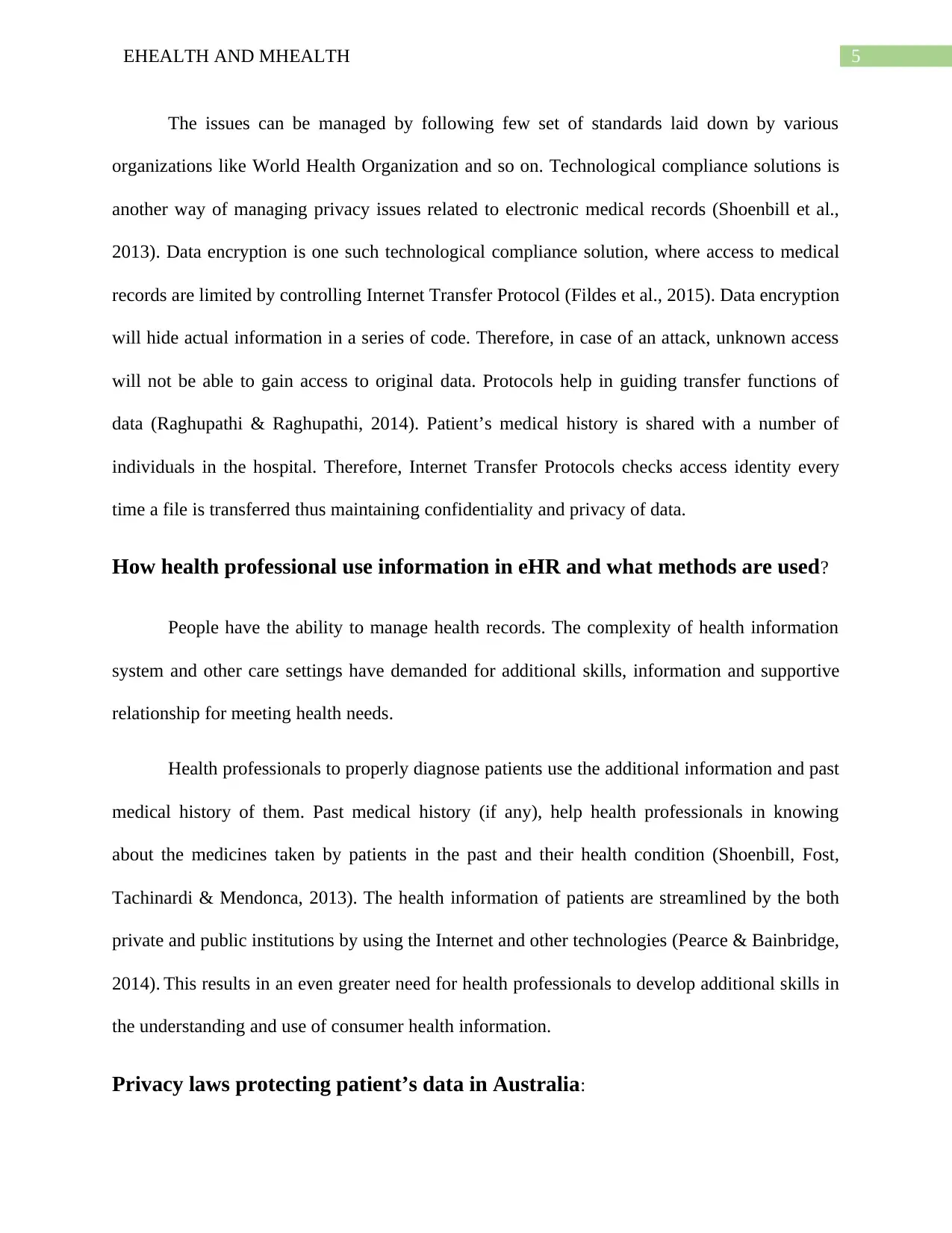
5EHEALTH AND MHEALTH
The issues can be managed by following few set of standards laid down by various
organizations like World Health Organization and so on. Technological compliance solutions is
another way of managing privacy issues related to electronic medical records (Shoenbill et al.,
2013). Data encryption is one such technological compliance solution, where access to medical
records are limited by controlling Internet Transfer Protocol (Fildes et al., 2015). Data encryption
will hide actual information in a series of code. Therefore, in case of an attack, unknown access
will not be able to gain access to original data. Protocols help in guiding transfer functions of
data (Raghupathi & Raghupathi, 2014). Patient’s medical history is shared with a number of
individuals in the hospital. Therefore, Internet Transfer Protocols checks access identity every
time a file is transferred thus maintaining confidentiality and privacy of data.
How health professional use information in eHR and what methods are used?
People have the ability to manage health records. The complexity of health information
system and other care settings have demanded for additional skills, information and supportive
relationship for meeting health needs.
Health professionals to properly diagnose patients use the additional information and past
medical history of them. Past medical history (if any), help health professionals in knowing
about the medicines taken by patients in the past and their health condition (Shoenbill, Fost,
Tachinardi & Mendonca, 2013). The health information of patients are streamlined by the both
private and public institutions by using the Internet and other technologies (Pearce & Bainbridge,
2014). This results in an even greater need for health professionals to develop additional skills in
the understanding and use of consumer health information.
Privacy laws protecting patient’s data in Australia:
The issues can be managed by following few set of standards laid down by various
organizations like World Health Organization and so on. Technological compliance solutions is
another way of managing privacy issues related to electronic medical records (Shoenbill et al.,
2013). Data encryption is one such technological compliance solution, where access to medical
records are limited by controlling Internet Transfer Protocol (Fildes et al., 2015). Data encryption
will hide actual information in a series of code. Therefore, in case of an attack, unknown access
will not be able to gain access to original data. Protocols help in guiding transfer functions of
data (Raghupathi & Raghupathi, 2014). Patient’s medical history is shared with a number of
individuals in the hospital. Therefore, Internet Transfer Protocols checks access identity every
time a file is transferred thus maintaining confidentiality and privacy of data.
How health professional use information in eHR and what methods are used?
People have the ability to manage health records. The complexity of health information
system and other care settings have demanded for additional skills, information and supportive
relationship for meeting health needs.
Health professionals to properly diagnose patients use the additional information and past
medical history of them. Past medical history (if any), help health professionals in knowing
about the medicines taken by patients in the past and their health condition (Shoenbill, Fost,
Tachinardi & Mendonca, 2013). The health information of patients are streamlined by the both
private and public institutions by using the Internet and other technologies (Pearce & Bainbridge,
2014). This results in an even greater need for health professionals to develop additional skills in
the understanding and use of consumer health information.
Privacy laws protecting patient’s data in Australia:
⊘ This is a preview!⊘
Do you want full access?
Subscribe today to unlock all pages.

Trusted by 1+ million students worldwide
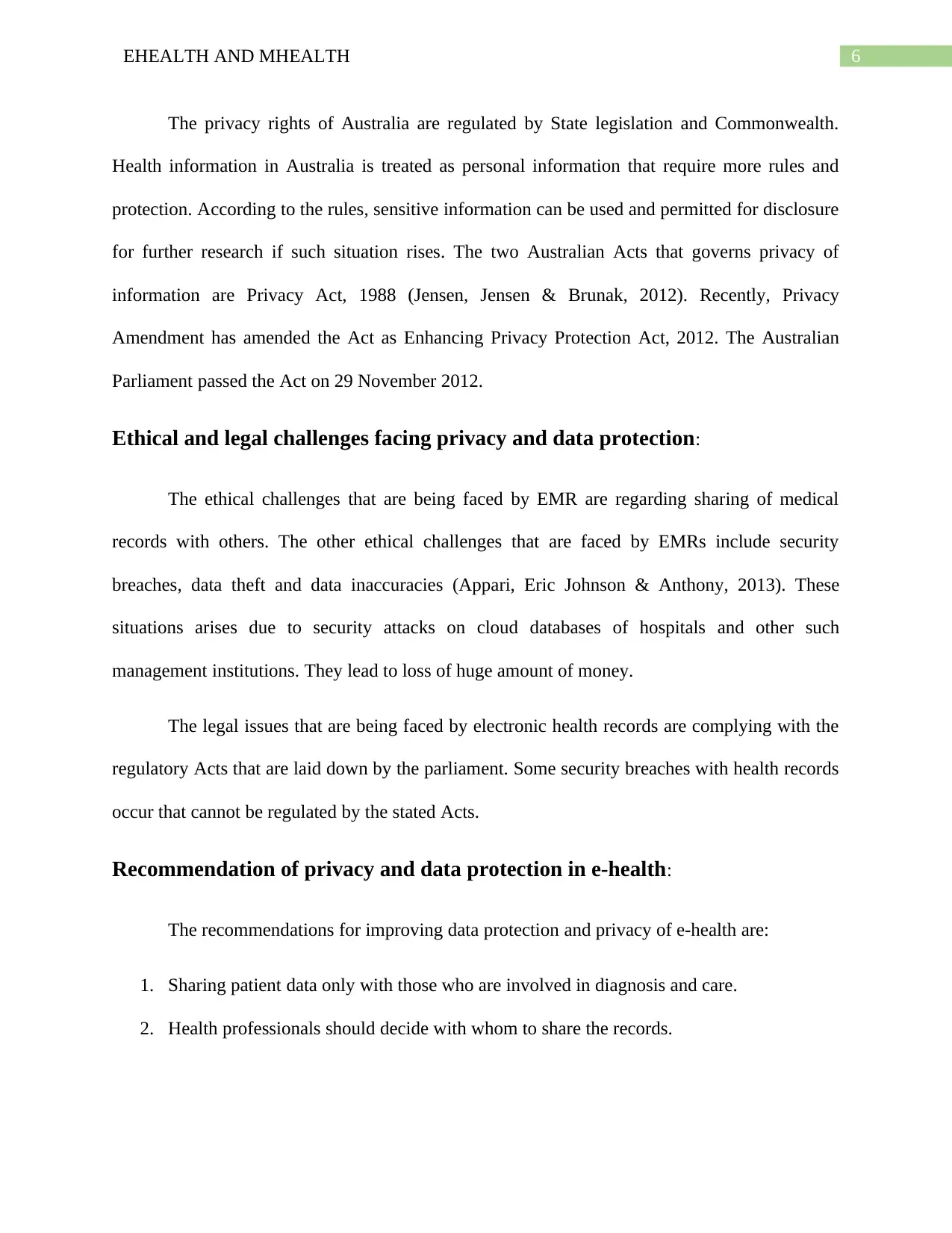
6EHEALTH AND MHEALTH
The privacy rights of Australia are regulated by State legislation and Commonwealth.
Health information in Australia is treated as personal information that require more rules and
protection. According to the rules, sensitive information can be used and permitted for disclosure
for further research if such situation rises. The two Australian Acts that governs privacy of
information are Privacy Act, 1988 (Jensen, Jensen & Brunak, 2012). Recently, Privacy
Amendment has amended the Act as Enhancing Privacy Protection Act, 2012. The Australian
Parliament passed the Act on 29 November 2012.
Ethical and legal challenges facing privacy and data protection:
The ethical challenges that are being faced by EMR are regarding sharing of medical
records with others. The other ethical challenges that are faced by EMRs include security
breaches, data theft and data inaccuracies (Appari, Eric Johnson & Anthony, 2013). These
situations arises due to security attacks on cloud databases of hospitals and other such
management institutions. They lead to loss of huge amount of money.
The legal issues that are being faced by electronic health records are complying with the
regulatory Acts that are laid down by the parliament. Some security breaches with health records
occur that cannot be regulated by the stated Acts.
Recommendation of privacy and data protection in e-health:
The recommendations for improving data protection and privacy of e-health are:
1. Sharing patient data only with those who are involved in diagnosis and care.
2. Health professionals should decide with whom to share the records.
The privacy rights of Australia are regulated by State legislation and Commonwealth.
Health information in Australia is treated as personal information that require more rules and
protection. According to the rules, sensitive information can be used and permitted for disclosure
for further research if such situation rises. The two Australian Acts that governs privacy of
information are Privacy Act, 1988 (Jensen, Jensen & Brunak, 2012). Recently, Privacy
Amendment has amended the Act as Enhancing Privacy Protection Act, 2012. The Australian
Parliament passed the Act on 29 November 2012.
Ethical and legal challenges facing privacy and data protection:
The ethical challenges that are being faced by EMR are regarding sharing of medical
records with others. The other ethical challenges that are faced by EMRs include security
breaches, data theft and data inaccuracies (Appari, Eric Johnson & Anthony, 2013). These
situations arises due to security attacks on cloud databases of hospitals and other such
management institutions. They lead to loss of huge amount of money.
The legal issues that are being faced by electronic health records are complying with the
regulatory Acts that are laid down by the parliament. Some security breaches with health records
occur that cannot be regulated by the stated Acts.
Recommendation of privacy and data protection in e-health:
The recommendations for improving data protection and privacy of e-health are:
1. Sharing patient data only with those who are involved in diagnosis and care.
2. Health professionals should decide with whom to share the records.
Paraphrase This Document
Need a fresh take? Get an instant paraphrase of this document with our AI Paraphraser
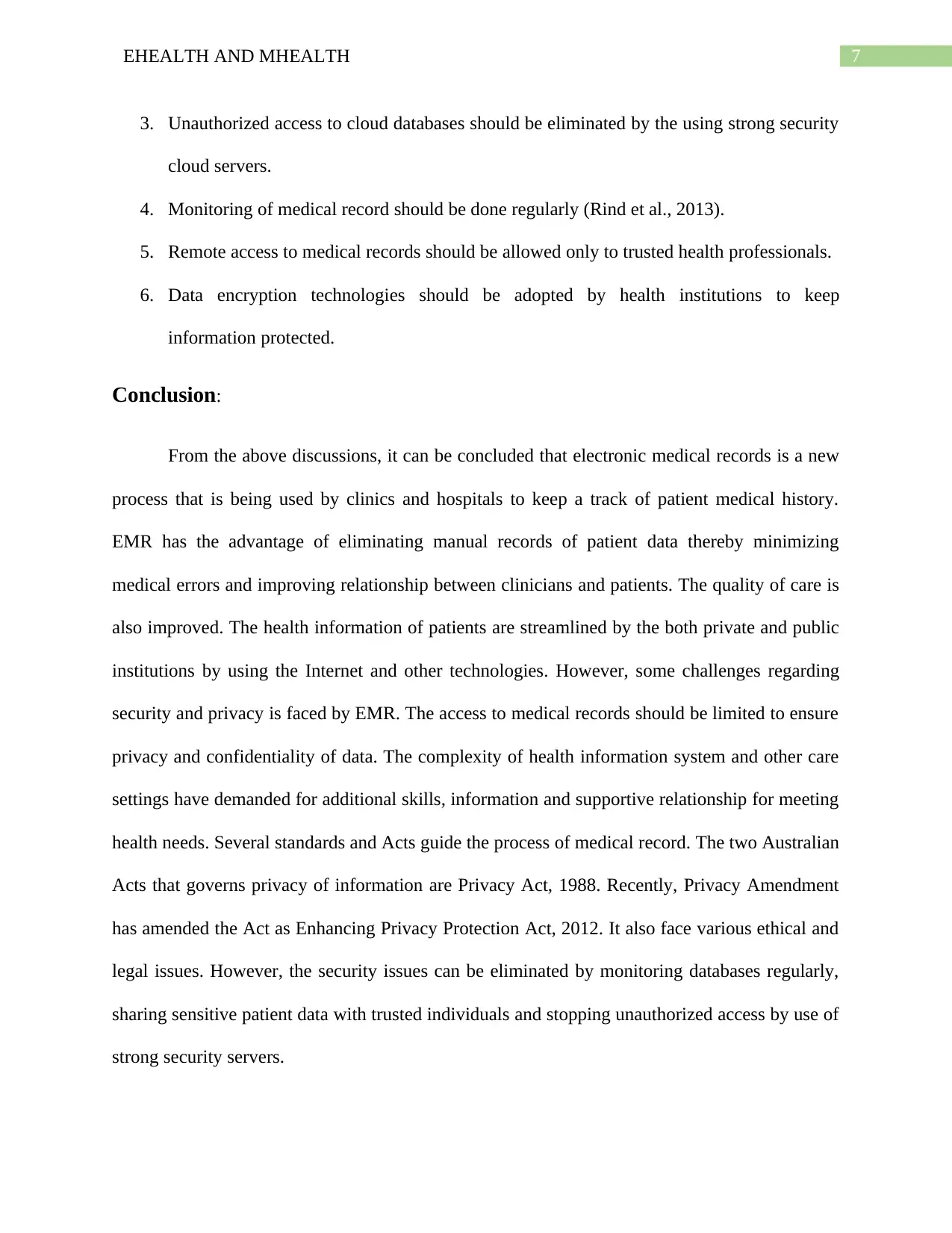
7EHEALTH AND MHEALTH
3. Unauthorized access to cloud databases should be eliminated by the using strong security
cloud servers.
4. Monitoring of medical record should be done regularly (Rind et al., 2013).
5. Remote access to medical records should be allowed only to trusted health professionals.
6. Data encryption technologies should be adopted by health institutions to keep
information protected.
Conclusion:
From the above discussions, it can be concluded that electronic medical records is a new
process that is being used by clinics and hospitals to keep a track of patient medical history.
EMR has the advantage of eliminating manual records of patient data thereby minimizing
medical errors and improving relationship between clinicians and patients. The quality of care is
also improved. The health information of patients are streamlined by the both private and public
institutions by using the Internet and other technologies. However, some challenges regarding
security and privacy is faced by EMR. The access to medical records should be limited to ensure
privacy and confidentiality of data. The complexity of health information system and other care
settings have demanded for additional skills, information and supportive relationship for meeting
health needs. Several standards and Acts guide the process of medical record. The two Australian
Acts that governs privacy of information are Privacy Act, 1988. Recently, Privacy Amendment
has amended the Act as Enhancing Privacy Protection Act, 2012. It also face various ethical and
legal issues. However, the security issues can be eliminated by monitoring databases regularly,
sharing sensitive patient data with trusted individuals and stopping unauthorized access by use of
strong security servers.
3. Unauthorized access to cloud databases should be eliminated by the using strong security
cloud servers.
4. Monitoring of medical record should be done regularly (Rind et al., 2013).
5. Remote access to medical records should be allowed only to trusted health professionals.
6. Data encryption technologies should be adopted by health institutions to keep
information protected.
Conclusion:
From the above discussions, it can be concluded that electronic medical records is a new
process that is being used by clinics and hospitals to keep a track of patient medical history.
EMR has the advantage of eliminating manual records of patient data thereby minimizing
medical errors and improving relationship between clinicians and patients. The quality of care is
also improved. The health information of patients are streamlined by the both private and public
institutions by using the Internet and other technologies. However, some challenges regarding
security and privacy is faced by EMR. The access to medical records should be limited to ensure
privacy and confidentiality of data. The complexity of health information system and other care
settings have demanded for additional skills, information and supportive relationship for meeting
health needs. Several standards and Acts guide the process of medical record. The two Australian
Acts that governs privacy of information are Privacy Act, 1988. Recently, Privacy Amendment
has amended the Act as Enhancing Privacy Protection Act, 2012. It also face various ethical and
legal issues. However, the security issues can be eliminated by monitoring databases regularly,
sharing sensitive patient data with trusted individuals and stopping unauthorized access by use of
strong security servers.

8EHEALTH AND MHEALTH
⊘ This is a preview!⊘
Do you want full access?
Subscribe today to unlock all pages.

Trusted by 1+ million students worldwide

9EHEALTH AND MHEALTH
References:
Appari, A., Eric Johnson, M., & Anthony, D. L. (2013). Meaningful use of electronic health
record systems and process quality of care: evidence from a panel data analysis of US
acute‐care hospitals. Health services research, 48(2pt1), 354-375.
Coorevits, P., Sundgren, M., Klein, G. O., Bahr, A., Claerhout, B., Daniel, C., ... & De Moor, G.
(2013). Electronic health records: new opportunities for clinical research. Journal of
internal medicine, 274(6), 547-560.
Fildes, A., Charlton, J., Rudisill, C., Littlejohns, P., Prevost, A. T., & Gulliford, M. C. (2015).
Probability of an obese person attaining normal body weight: cohort study using
electronic health records. American Journal of Public Health, 105(9), e54-e59.
Gajanayake, R., Iannella, R., & Sahama, T. (2014). Privacy oriented access control for electronic
health records. electronic Journal of Health Informatics, 8(2), 15.
Jensen, P. B., Jensen, L. J., & Brunak, S. (2012). Mining electronic health records: towards better
research applications and clinical care. Nature Reviews Genetics, 13(6), 395.
Moja, L., Kwag, K. H., Lytras, T., Bertizzolo, L., Brandt, L., Pecoraro, V., ... & Iorio, A. (2014).
Effectiveness of computerized decision support systems linked to electronic health
records: a systematic review and meta-analysis. American journal of public health,
104(12), e12-e22.
Patil, H. K., & Seshadri, R. (2014, June). Big data security and privacy issues in healthcare. In
Big Data (BigData Congress), 2014 IEEE International Congress on (pp. 762-765).
IEEE.
References:
Appari, A., Eric Johnson, M., & Anthony, D. L. (2013). Meaningful use of electronic health
record systems and process quality of care: evidence from a panel data analysis of US
acute‐care hospitals. Health services research, 48(2pt1), 354-375.
Coorevits, P., Sundgren, M., Klein, G. O., Bahr, A., Claerhout, B., Daniel, C., ... & De Moor, G.
(2013). Electronic health records: new opportunities for clinical research. Journal of
internal medicine, 274(6), 547-560.
Fildes, A., Charlton, J., Rudisill, C., Littlejohns, P., Prevost, A. T., & Gulliford, M. C. (2015).
Probability of an obese person attaining normal body weight: cohort study using
electronic health records. American Journal of Public Health, 105(9), e54-e59.
Gajanayake, R., Iannella, R., & Sahama, T. (2014). Privacy oriented access control for electronic
health records. electronic Journal of Health Informatics, 8(2), 15.
Jensen, P. B., Jensen, L. J., & Brunak, S. (2012). Mining electronic health records: towards better
research applications and clinical care. Nature Reviews Genetics, 13(6), 395.
Moja, L., Kwag, K. H., Lytras, T., Bertizzolo, L., Brandt, L., Pecoraro, V., ... & Iorio, A. (2014).
Effectiveness of computerized decision support systems linked to electronic health
records: a systematic review and meta-analysis. American journal of public health,
104(12), e12-e22.
Patil, H. K., & Seshadri, R. (2014, June). Big data security and privacy issues in healthcare. In
Big Data (BigData Congress), 2014 IEEE International Congress on (pp. 762-765).
IEEE.
Paraphrase This Document
Need a fresh take? Get an instant paraphrase of this document with our AI Paraphraser
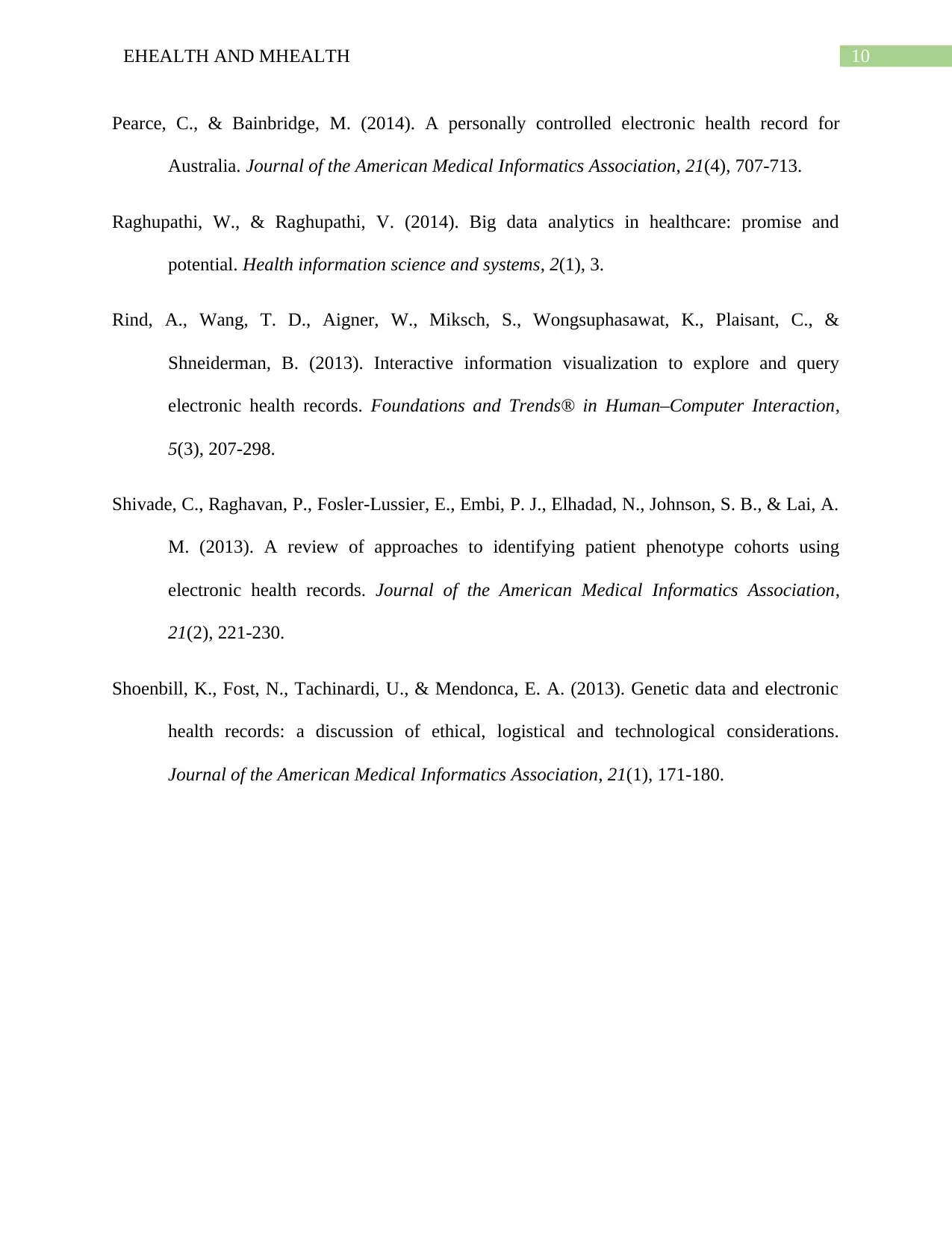
10EHEALTH AND MHEALTH
Pearce, C., & Bainbridge, M. (2014). A personally controlled electronic health record for
Australia. Journal of the American Medical Informatics Association, 21(4), 707-713.
Raghupathi, W., & Raghupathi, V. (2014). Big data analytics in healthcare: promise and
potential. Health information science and systems, 2(1), 3.
Rind, A., Wang, T. D., Aigner, W., Miksch, S., Wongsuphasawat, K., Plaisant, C., &
Shneiderman, B. (2013). Interactive information visualization to explore and query
electronic health records. Foundations and Trends® in Human–Computer Interaction,
5(3), 207-298.
Shivade, C., Raghavan, P., Fosler-Lussier, E., Embi, P. J., Elhadad, N., Johnson, S. B., & Lai, A.
M. (2013). A review of approaches to identifying patient phenotype cohorts using
electronic health records. Journal of the American Medical Informatics Association,
21(2), 221-230.
Shoenbill, K., Fost, N., Tachinardi, U., & Mendonca, E. A. (2013). Genetic data and electronic
health records: a discussion of ethical, logistical and technological considerations.
Journal of the American Medical Informatics Association, 21(1), 171-180.
Pearce, C., & Bainbridge, M. (2014). A personally controlled electronic health record for
Australia. Journal of the American Medical Informatics Association, 21(4), 707-713.
Raghupathi, W., & Raghupathi, V. (2014). Big data analytics in healthcare: promise and
potential. Health information science and systems, 2(1), 3.
Rind, A., Wang, T. D., Aigner, W., Miksch, S., Wongsuphasawat, K., Plaisant, C., &
Shneiderman, B. (2013). Interactive information visualization to explore and query
electronic health records. Foundations and Trends® in Human–Computer Interaction,
5(3), 207-298.
Shivade, C., Raghavan, P., Fosler-Lussier, E., Embi, P. J., Elhadad, N., Johnson, S. B., & Lai, A.
M. (2013). A review of approaches to identifying patient phenotype cohorts using
electronic health records. Journal of the American Medical Informatics Association,
21(2), 221-230.
Shoenbill, K., Fost, N., Tachinardi, U., & Mendonca, E. A. (2013). Genetic data and electronic
health records: a discussion of ethical, logistical and technological considerations.
Journal of the American Medical Informatics Association, 21(1), 171-180.
1 out of 11
Related Documents
Your All-in-One AI-Powered Toolkit for Academic Success.
+13062052269
info@desklib.com
Available 24*7 on WhatsApp / Email
![[object Object]](/_next/static/media/star-bottom.7253800d.svg)
Unlock your academic potential
Copyright © 2020–2026 A2Z Services. All Rights Reserved. Developed and managed by ZUCOL.





